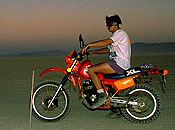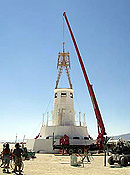The Organization of Burning Man
The first decision-making body that managed Burning Man comprised Larry Harvey and Jerry James. Larry was a landscaper, and Jerry was a professional carpenter. On June 21, 1986, Larry called his friend and proposed that they build a wooden man and burn it on a beach in San Francisco. That afternoon, they constructed the 8 ft. tall figure in a garage, then asked a few friends to help transport the statue. During the next few years, as the Burning Man gradually increased in size and the crowds at Baker Beach grew larger, several other people joined them in what came to be called the Project. Many of these early volunteers were carpenters and people skilled in the construction trades. By 1990, Burning Man had grown to nearly 40 ft. in height, and the Project now included many members of San Francisco’s Cacophony Society, a group of artists and urban pranksters devoted to creating interactive events.
 1990 also marked the year that Burning Man moved from San Francisco to the Black Rock Desert. Larry now worked with John Law and Michael Michael, leading lights of the Cacophony society. These three individuals formed a steering committee of sorts, although the word “committee” is almost too formal a term. They were the ones who got things done as leaders at the center of a loose-knit social network of friends and volunteers. Many management responsibilities simply defaulted to them. John took responsibility for transporting the Man to the desert, installing it with neon lighting, and locating and surveying the desert site. Michael served as treasurer, managed much of Burning Man’s mailings, and, in 1992, founded the Black Rock Rangers. Larry recruited artists, created a city plan, secured permits and the event’s insurance policy, served as spokesperson to the media, and supervised the design and construction of the Man. General meetings were anarchic affairs. Oftentimes, the floor belonged to anyone possessed of strong convictions and a carrying voice. The Project in these early years was like a moderately sized theme camp. Decision-making was a very casual affair.
1990 also marked the year that Burning Man moved from San Francisco to the Black Rock Desert. Larry now worked with John Law and Michael Michael, leading lights of the Cacophony society. These three individuals formed a steering committee of sorts, although the word “committee” is almost too formal a term. They were the ones who got things done as leaders at the center of a loose-knit social network of friends and volunteers. Many management responsibilities simply defaulted to them. John took responsibility for transporting the Man to the desert, installing it with neon lighting, and locating and surveying the desert site. Michael served as treasurer, managed much of Burning Man’s mailings, and, in 1992, founded the Black Rock Rangers. Larry recruited artists, created a city plan, secured permits and the event’s insurance policy, served as spokesperson to the media, and supervised the design and construction of the Man. General meetings were anarchic affairs. Oftentimes, the floor belonged to anyone possessed of strong convictions and a carrying voice. The Project in these early years was like a moderately sized theme camp. Decision-making was a very casual affair.
Beginning in 1990 with 80 participants, Black Rock City’s population increased to 1,000 attendees in 1993, and these numbers doubled each year. By 1995 our population had grown to 4,000 people. As the organizers prepared for 1996, it was apparent that our previous decision-making methods could no longer coordinate the complex tasks confronting us. Ad hoc understandings, third-hand information, vague pledges of personal assistance and an increasingly ambiguous flow of money through our organization were insufficient to manage a growing city. We needed to produce an overview. Responsibilities and relationships implicit in our former mode of operation now needed to be formalized. That year Larry founded Burning Man’s first version of a senior staff. It was from this seed that our present organization, with its several tiers of decision-making and its many levels of consensus formation, has grown. The time had come, in other words, for Burning Man’s organizers to kick themselves upstairs.
So much has occurred during the intervening years that it is almost possible to forget people’s roles. Fortunately, however, this also marks the end of what could be termed Burning Man’s prehistoric period. As we began to regularly hold meetings, we also began to produce and preserve paperwork. A staff chart from 1996 reveals that an executive committee managed this first senior staff. This included Larry, who served as director of the Project and media spokesperson, produced Burning Man’s annual art theme, and co-chaired Burning Man’s art department. John Law headed playa operations. He supervised transportation and Black Rock City’s physical plant in the desert, served as a liaison to government agencies, surveyed and laid out Black Rock City, and managed our cleanup effort. Michael Michael supervised mailings and our ticket process, designed and controlled our telephone messaging system, and oversaw finances.
A second tier of mangers completed this committee. Dana Albany acted as Larry’s assistant for art production. Harley Dubois served as our camp manager, event scheduler, and theme camp coordinator. Joegh Bullock oversaw the construction and management of a central stage. Crimson Rose co-chaired the art department with Larry and served as art pageant coordinator. Stuart Mangrum edited and published the Black Rock Gazette and Burning Man’s newsletter. Vanessa Kummerele supervised the Black Rock Rangers. Dan Miller now took charge of constructing and erecting Burning Man. Furthermore, beneath this tier of organizers, a host of other managers and helpers now saw to such tasks as scheduling and coordinating press interviews, planning and constructing our central café, designing and maintaining Burning Man’s website, managing our playa radio system, supervising our city’s gate and maintaining our phone logs. Burning Man began to generate fairly complex organization. On the other hand, the diagram that charts these relationships takes up a single sheet of paper. Our current operations manual, with its many mission statements, job descriptions, procedural forms and departmental staff charts, runs to 222 pages.
 In 1997, a new executive committee was formed to manage the Project. It became a Limited Liability Company (LLC). Today, six people belong to this group. The LLC is an executive policy making body with very broad responsibilities. This committee supervises salaries, hiring, firing, and undertakes all financial and policy decisions that affect the survival and the long-term goals of Burning Man. This executive board forms a part of Burning Man’s Senior Staff. Representatives from all of the major departments of Burning Man are represented on Senior Staff. This group is responsible for the day-to-day administration of the Project. In 2001 a new group called Consulting Senior Staff was added to this committee. These new members are responsible for communicating information that is shared by all departments. Some departments of the Project have also evolved their own senior staffs. The Black Rock Rangers and the DPW have begun to develop decision-making hierarchies that extend into three tiers.
In 1997, a new executive committee was formed to manage the Project. It became a Limited Liability Company (LLC). Today, six people belong to this group. The LLC is an executive policy making body with very broad responsibilities. This committee supervises salaries, hiring, firing, and undertakes all financial and policy decisions that affect the survival and the long-term goals of Burning Man. This executive board forms a part of Burning Man’s Senior Staff. Representatives from all of the major departments of Burning Man are represented on Senior Staff. This group is responsible for the day-to-day administration of the Project. In 2001 a new group called Consulting Senior Staff was added to this committee. These new members are responsible for communicating information that is shared by all departments. Some departments of the Project have also evolved their own senior staffs. The Black Rock Rangers and the DPW have begun to develop decision-making hierarchies that extend into three tiers.
This many-tiered organization has evolved organically out of our need to achieve an overview and communicate with one another as we coordinate many different activities. It is also the very practical result of delegating responsibility. At increasingly higher levels of management, a lot of time is spent attending meetings, discussing and producing policies, overseeing budgets, crafting timelines, handling paperwork, responding to emails and delegating responsibility for what comes to be called “operations.” For those who prefer direct action and immediate results, this may have a certain air of unreality. But most of the people who perform these tasks began as workers in the field. They are participants who stepped forward to lick envelopes, pound stakes, saw wood and accomplish many of the other concrete chores they supervise today. They are people who were willing, at certain crucial junctures in Burning Man’s history, to assume a greater responsibility for helping others accomplish things.
The management of our Project also bears the stamp of its origins in another way. The organization of Burning Man grew out of a community. Within this community, many decisions were made by consensus. This is the natural mode of decision-making in any communal group, and, today, we still operate in this fashion. At every level of our organization, from policies created by the LLC to decisions made at the most immediate level of operations, we employ a consensus process. The interplay between consensus-making and a hierarchic structure of organization defines our Project. Some of the principles that guide us are discussed in a document entitled “Consensus, hierarchy, authority and power”. It outlines our fundamental philosophy of management.

